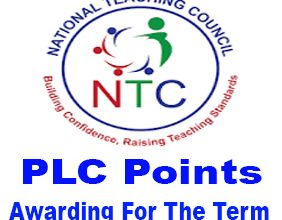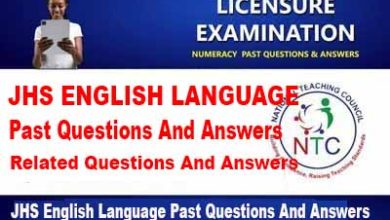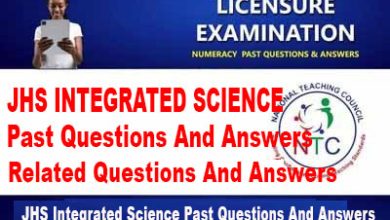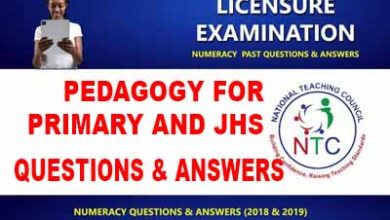Social Studies For JHS (NTC Exams Questions And Answers 2024) 3
Social Studies For JHS
- Which major feature of the Earth is composed of the crust and upper part of the mantle?
a) Atmosphere
b) Lithosphere
c) Vegetation
d) Water Bodies
Correct Answers: b) Lithosphere
2. What role does the atmosphere play in regulating Earth’s temperature and protecting the planet?
a) Absorbing carbon dioxide
b) Shielding from meteors
c) Regulating tides
d) Protecting from harmful solar radiation
Correct Answers: d) Protecting from harmful solar radiation
3. What major feature plays a vital role in maintaining soil health, providing habitat, and regulating climate?
a) Highlands
b) Lowlands
c) Vegetation
d) Water Bodies
Correct Answers: c) Vegetation
4. What covers more than 70% of the Earth’s surface and plays a fundamental role in regulating the climate?
a) Lakes
b) Vegetation
c) Oceans
d) Atmosphere
Correct Answers: c) Vegetation
5. Which major feature is characterized by mountainous areas and valleys?
a) Lithosphere
b) Water Bodies
c) Atmosphere
d) Highlands
Correct Answers: c) Oceans
6. What is the solid, outermost shell of the Earth called?
a) Atmosphere
b) Lithosphere
c) Oceans
d) Vegetation
Correct Answers: a) Lithosphere
7. Which major feature is composed of nitrogen, oxygen, and other gases, and surrounds the Earth?
a) Lithosphere
b) Water Bodies
c) Atmosphere
d) Highlands
Correct Answers: c) Atmosphere
8. What is the role of the oceans in the Earth’s system?
a) Storing carbon
b) Supporting vegetation
c) Regulating soil health
d) Producing oxygen
Correct Answers: a) Storing carbon
9. According to the information provided, which feature is characterized by forests, grasslands, deserts, and other ecosystems?
a) Highlands
b) Atmosphere
c) Lithosphere
d) Vegetation
Correct Answers: d) Vegetation
10. Which major feature is characterized by varying elevations and includes mountains and valleys?
a) Atmosphere
b) Highlands and Lowlands
c) Oceans
d) Lithosphere
Correct Answers: b) Highlands and Lowlands
11.Which of the following is not a water body in Ghana:
(a) Volta Lake
(b) Black Volta
(c) Tano
(d) Accra
The correct answer is (d).Accra
12.Which of the following is not a type of vegetation in Ghana:
(a) Moist semi-deciduous forest
(b) Tropical rain forest
(c) Savannah
(d) Strand
The correct answer is (d).Strand is a type of beach, not a type of vegetation.
13.Which of the following is not a continent:
(a) Africa
(b) Oceania
(c) North America
(d) Antarctica
The correct answer is (b).Oceania is a region of the world, not a continent.
14.Which of the following is not a type of map:
(a) Physical map
(b) Political map
(c) Human-made map
(d) World map
The correct answer is (c).Human-made map is not a type of map, it is a type of mapmaker.
15.Which of the following is not a physical feature of the earth:
(a) River
(b) Mountain
(c) City
(d) Forest
The correct answer is (c).City is a human-made feature, not a physical feature.
16. Which river in Ghana flows through the Greater Accra Region before emptying into the Gulf of Guinea?
A) Ankobra River
B) Black Volta
C) Densu River
D) White Volta
Correct Answer: C) Densu River
17. Where is the Volta Lake located?
A) Burkina Faso
B) Western Region of Ghana
C) Central Region of Ghana
D) Eastern Region of Ghana
Correct Answer: D) Eastern Region of Ghana
18. Which vegetation type is predominant in the central and southern parts of Ghana?
A) Tropical Rainforest
B) Savannah
C) Semi-Deciduous Forest
D) Scrub and Grassland
Correct Answer: C) Semi-Deciduous Forest
19. What type of vegetation is typically found along the coastline of Ghana?
A) Tropical Rainforest
B) Savannah
C) Coastal
D) Scrub and Grassland
Correct Answer: C) Coastal
20. Which continent is Ghana located on?
A) Oceania
B) North America
C) Asia
D) Africa
Correct Answer: D) Africa
21. What does “family life” primarily refer to?
A) The physical changes during adolescence
B) The dynamics within a family unit
C) Access to reproductive healthcare services
D) Cultural traditions and rituals
Answer: B) The dynamics within a family unit
22. Which of the following is NOT a key aspect of adolescence?
A) Physical changes
B) Social relationships
C) Financial independence
D) Identity formation
Answer: C) Financial independence
23. Which component of reproductive health involves access to contraception and family planning services?
A) Sexual health education
B) STI prevention
C) Family planning
D) Safe motherhood
Answer: C) Family planning
24. What is the primary purpose of comprehensive sexuality education?
A) To promote abstinence-only programs
B) To provide accurate information about sexual health
C) To discourage discussions about healthy relationships
D) To limit access to reproductive healthcare services
Answer: B) To provide accurate information about sexual health
25. Which factor significantly influences adolescent development and well-being?
A) Lack of peer relationships
B) Limited access to reproductive healthcare
C) Family support and communication
D) Strict adherence to traditional gender roles
Answer: C) Family support and communication
26. What do reproductive rights encompass?
A) The right to make autonomous decisions about one’s body
B) The obligation to conform to societal expectations
C) The restriction of access to contraception
D) The promotion of discriminatory practices
Answer: A) The right to make autonomous decisions about one’s body
27. What is a key goal of STI prevention and treatment within reproductive health?
A) Encouraging risky sexual behavior
B) Reducing the risk of STI transmission
C) Promoting stigma and discrimination
D) Limiting access to healthcare services
Answer: B) Reducing the risk of STI transmission
28. How do rituals and traditions contribute to family life?
A) By promoting isolation from society
B) By fostering a sense of belonging and continuity
C) By discouraging open communication
D) By imposing rigid gender roles
Answer: B) By fostering a sense of belonging and continuity
29. What is a significant cognitive development during adolescence?
A) Concrete operational thinking
B) Abstract thinking
C) Sensorimotor intelligence
D) Egocentric thought
Answer: B) Abstract thinking
30. What role does effective communication play in family life?
A) It promotes misunderstanding and conflict
B) It fosters emotional support and understanding
C) It discourages open dialogue and trust
D) It enforces strict rules and regulations
Answer: B) It fosters emotional support and understanding
31. Which of the following is not a part of family life:
(a) Parents
(b) Children
(c) Friends
(d) Siblings
The correct answer is (c).Friends are not a part of family life, they are a part of social life.
32. Which of the following is not a challenge faced by adolescents:
(a) Developing their own identity
(b) Making decisions about their future
(c) Dealing with the pressures of peer pressure and social media
(d) Having a safe and satisfying sex life
The correct answer is (d).Having a safe and satisfying sex life is not a challenge faced by adolescents, it is a goal that they should strive for.
33. Which of the following is not a part of reproductive health:
(a) The ability to have a safe and satisfying sex life
(b) The ability to reproduce
(c) The ability to prevent pregnancy and sexually transmitted infections
(d) The ability to have a healthy pregnancy and childbirth
The correct answer is (d).The ability to have a healthy pregnancy and childbirth is not a part of reproductive health, it is a part of maternal health.
34. Which of the following is not a risk factor for developing reproductive health problems in adolescents:
(a) Engaging in risky sexual behaviors
(b) Having multiple sexual partners
(c) Not using contraception
(d) Having a healthy diet
The correct answer is (d).Having a healthy diet is not a risk factor for developing reproductive health problems in adolescents, it is a factor that can help to prevent them.
35. Which of the following is not a component of comprehensive reproductive health education:
(a) Sexual development
(b) Contraception
(c) Sexually transmitted infections
(d) Pregnancy
The correct answer is (d).Pregnancy is not a component of comprehensive reproductive health education, it is a topic that is covered in more specialized reproductive health education programs.
36. Which of the following is not a component of quality reproductive health care:
(a) Preventive services
(b) Contraception counseling
(c) Treatment for reproductive health problems
(d) Pregnancy
The correct answer is (d).Pregnancy is not a component of quality reproductive health care, it is a topic that is covered in more specialized reproductive health care programs.
37. Which of the following is not a way to reduce the risk of developing reproductive health problems in adolescents:
(a) Having access to comprehensive reproductive health education
(b) Having access to quality reproductive health care
(c) Engaging in risky sexual behaviors
(d) Having multiple sexual partners
The correct answer is (c).Engaging in risky sexual behaviors is not a way to reduce the risk of developing reproductive health problems in adolescents, it is a risk factor for developing them.
38. Which of the following is not a goal of comprehensive reproductive health education:
(a) To help adolescents make informed decisions about their sexual health
(b) To reduce the risk of developing reproductive health problems
(c) To help adolescents have a safe and satisfying sex life
(d) To help adolescents have a healthy pregnancy and childbirth
The correct answer is (d). Helping adolescents have a healthy pregnancy and childbirth is not a goal of comprehensive reproductive health education, it is a goal of maternal health education.
39. Which of the following is not a goal of quality reproductive health care:
(a) To provide preventive services
(b) To provide contraception counseling
(c) To provide treatment for reproductive health problems
(d) To help adolescents have a healthy pregnancy and childbirth
The correct answer is (d).Helping adolescents have a healthy pregnancy and childbirth is not a goal of quality reproductive health care, it is a goal of maternal health care.
40. Which of the following is not a benefit of having access to comprehensive reproductive health education and care:
(a) Adolescents can make informed decisions about their sexual health
(b) Adolescents can reduce their risk of developing reproductive health problems
(c) Adolescents can have a safe and satisfying sex life
(d) Adolescents can have a healthy pregnancy and childbirth
The correct answer is (d).Having access to comprehensive reproductive health education and care does not guarantee that adolescents will have a healthy pregnancy and childbirth. There are many other factors that can affect the outcome of a pregnancy, such as the health of the mother and the baby, the quality of prenatal care, and the type of delivery.






